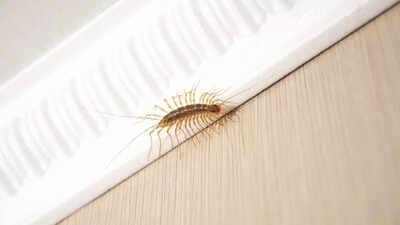5 effective ways to prevent centipedes from entering your house |

Centipedes may not be the most harmful household pests, but their sudden presence can still be unnerving. As temperatures rise, these many-legged creatures often seek shelter indoors, usually in dark, damp areas. While they rarely pose a direct threat to humans, centipedes’ appearance often signals underlying issues such as other insect infestations or excess moisture. Understanding what draws centipedes inside and how to prevent their entry is essential to maintaining a comfortable, pest-free home. This guide explains why centipedes invade, how to spot a potential problem, and practical steps to keep them, and their prey, out for good.
What attracts centipedes inside your house?
Centipedes are predatory arthropods that hunt insects such as spiders, ants, silverfish, and cockroaches. Their primary reason for entering homes is food; if these insects are present, centipedes are likely to follow. Moisture is another major factor that draws centipedes indoors. These creatures thrive in humid environments like bathrooms, kitchens, basements, and crawl spaces because damp conditions attract the small insects they feed on.In addition, centipedes prefer dark, sheltered areas. Being nocturnal, they avoid light and often hide in cracks, crevices, and cluttered spaces. As a result, they are commonly found tucked away under furniture, behind baseboards, or near plumbing fixtures. Finally, adverse weather conditions such as heavy rain, cold spells, or heatwaves can force centipedes to seek shelter inside homes to escape harsh environmental factors.
Signs you might have a centipede problem
Spotting one or two centipedes occasionally does not necessarily indicate an infestation, especially in older homes where these creatures sometimes live quietly in basements or crawl spaces. However, several signs suggest a more significant presence:
- Frequent sightings: A noticeable increase in centipede activity is the most obvious warning. If you find yourself seeing multiple centipedes regularly, this could indicate a larger population inside your home.
- Centipede moltings: As centipedes grow, they shed their exoskeletons, leaving behind translucent casings called moltings. These pale, lifeless shells often look like smaller, dull centipedes. Their presence suggests an active breeding population.
- Clusters or groupings: Multiple centipedes congregated in one area may mean they have found a reliable food source or a particularly comfortable habitat.
- Other pest infestations: Since centipedes prey on insects, a high number of ants, cockroaches, spiders, or silverfish can attract them. If you have ongoing problems with these pests, you may also have centipedes.
How to prevent centipedes from invading your home
The key to keeping centipedes away is controlling their food source and creating an environment that is inhospitable to them.
Eliminate other pests
Because centipedes feed on smaller insects, the first step is to address existing pest problems. Regular cleaning to remove food crumbs, vacuuming to eliminate dust and insect eggs, and decluttering to remove potential hiding places can reduce populations of ants, spiders, and cockroaches. Using pest control treatments targeted at these insects will also help reduce centipede attraction.
Seal entry points.
Centipedes can slip through small cracks and gaps in your home’s foundation, walls, windows, and doors. Inspect your property for openings and seal them with caulk or weather stripping. Pay special attention to areas around plumbing and electrical conduits, as well as spaces under doors and window frames. Keeping entry points closed prevents not only centipedes but also their prey from entering.
Reduce moisture levels
Humidity is a major attractant for centipedes and their prey. Managing moisture in your home can significantly reduce the chances of an infestation. Use dehumidifiers in damp areas such as basements and bathrooms. Fix any leaks in plumbing or roofing promptly. Additionally, make sure gutters and downspouts are clear of debris so that water drains properly away from the foundation.
Maintain weather stripping
Check the condition of weather stripping around doors and windows regularly. Damaged or worn weather stripping can allow moisture and pests to enter. Replacing it when necessary creates a tighter seal that helps keep centipedes out.
Reduce clutter and darkness
Since centipedes prefer dark, undisturbed areas, keeping your home tidy can discourage them from settling in. Avoid piles of clothes, papers, or firewood indoors, especially near exterior walls. Use adequate lighting in basements and closets to make these areas less inviting.If you notice an increasing number of centipedes despite your efforts, or if you find signs of large infestations such as numerous moltings or multiple centipedes clustered together, it may be time to consult a pest control professional. Experts can assess the extent of the problem, identify entry points you may have missed, and apply targeted treatments to eliminate centipedes and other pests effectively.Centipedes may be unsettling to find in your home, but with the right approach, you can keep them from getting comfortable indoors. By addressing moisture issues, controlling other pests, sealing entry points, and maintaining cleanliness, you create an environment that is unattractive to centipedes and their prey. These proactive steps will help ensure your home remains a safe, comfortable space, free from these unwelcome visitors.Also Read: 5 reasons why the tips of your houseplants are turning brown and how to fix them






